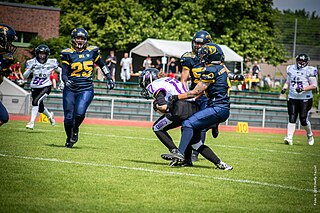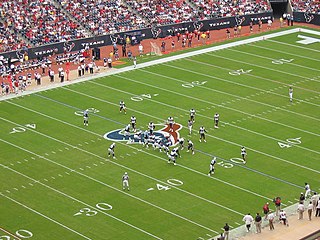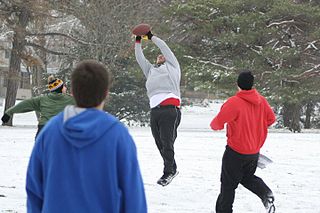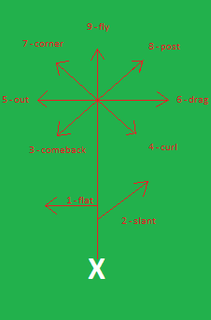
A running back (RB) is a member of the offensive backfield in gridiron football. The primary roles of a running back are to receive handoffs from the quarterback to rush the ball, to line up as a receiver to catch the ball, and block. There are usually one or two running backs on the field for a given play, depending on the offensive formation. A running back may be a halfback, a wingback or a fullback. A running back will sometimes be called a "feature back" if he is the team's starting running back.

A cornerback (CB) is a member of the defensive backfield or secondary in gridiron football. Cornerbacks cover receivers most of the time, but also blitz and defend against such offensive running plays as sweeps and reverses. They create turnovers through hard tackles, interceptions, and deflecting forward passes.
A wide receiver, also referred to as wideouts or simply receivers, is an offensive position in gridiron football, and is a key player. They get their name because they are split out "wide", farthest away from the rest of the team. Wide receivers are among the fastest players on the field. The wide receiver functions as the pass-catching specialist.
A screen pass is a play in gridiron football consisting of a short pass to a receiver who is protected by a screen of blockers. During a screen pass, a number of things happen concurrently in order to fool the defense into thinking a long pass is being thrown, when in fact the pass is merely a short one, just beyond the defensive linemen. Screens are usually deployed against aggressive defenses that rush the passer. Because screens invite the defense to rush the quarterback, they are designed to leave fewer defensemen behind the rushers to stop the play.
In gridiron football, blitzing is a tactic used by the defense to disrupt pass attempts by the offense. During a blitz, a higher than usual number of defensive players will rush the opposing quarterback, to try to tackle the quarterback or force him to hurry his pass attempt.

American and Canadian football are gridiron codes of football that are very similar; both have their origins in rugby football, but some key differences exist.
Strategy forms a major part of American football. Both teams plan many aspects of their plays (offense) and response to plays (defense), such as what formations they take, who they put on the field, and the roles and instructions each player are given. Throughout a game, each team adapts to the other's apparent strengths and weaknesses, trying various approaches to outmaneuver or overpower their opponent in order to win the game.

Gameplay in American football consists of a series of downs, individual plays of short duration, outside of which the ball is dead or not in play. These can be plays from scrimmage – passes, runs, punts, or field goal attempts – or free kicks such as kickoffs and fair catch kicks. Substitutions can be made between downs, which allows for a great deal of specialization as coaches choose the players best suited for each particular situation. During a play, each team should have no more than 11 players on the field, and each of them has specific tasks assigned for that specific play.
The hook and lateral is a trick play in American, Canadian football & indoor American football, often colloquially called the hook and ladder play.
In gridiron football, clock management is the manipulation of a game clock and play clock to achieve a desired result, typically near the end of a match. It is analogous to "running out the clock" seen in many sports, and the act of trying to hasten the game's end is often referred to by this term. Clock management strategies are a significant part of American football, where an elaborate set of rules dictates when the game clock stops between downs, and when it continues to run.

Single set back is an offensive base formation in American Football which requires only one running back lined up about five yards behind the quarterback. There are many variations on single back formations including two tight ends and two wide receivers, one tight end/three wide receivers, etc. The running back can line up directly behind the quarterback or offset either the weak side or the strong side.
A trick play, also known as a gadget play, gimmick play or trickeration, is a play in gridiron football that uses deception and unorthodox tactics to fool the opposing team. A trick play is often risky, offering the potential for a large gain or a touchdown if it is successful, but with the chance of a significant loss of yards or a turnover if not. Trick plays are rarely used not only because of the riskiness, but also to maintain the element of surprise for when they are used.

A halfback (HB) is an offensive position in American football, whose duties involve lining up in the backfield and carrying the ball on most rushing plays, i.e. a running back. When the principal ball carrier lines up deep in the backfield, and especially when that player is placed behind another player, as in the I formation, that player is instead referred to as a tailback.

In American football each team has 11 players on the field at one time. The specific role that a player takes on the field is called their position. Under the modern rules of American football, teams are allowed unlimited free substitutions; that is, teams may change any number of players after any play, at any point in the game. This has resulted in the development of three task-specific "platoons" of players within any single team: the offense, the defense, and the so-called 'special team'. Within these three separate "platoons", various specific positions exist depending on what each player's main job is.

Street football, also known as backyard football or sandlot football, is a simplified variant of American football primarily played informally by youth. It features far less equipment and fewer rules than its counterparts, but unlike the similar touch football, features full tackling.
In American football a play is a close to the ground "plan of action" or "strategy" used to move the ball down the field. A play begins at either the snap from the center or at kickoff. Most commonly plays occur at the snap during a down. These plays range from basic to very intricate. Football players keep a record of these plays in their playbook.

Zone coverage is a defense scheme in gridiron football used to protect against the pass.
The following terms are used in American football, both conventional and indoor. Some of these terms are also in use in Canadian football; for a list of terms unique to that code, see Glossary of Canadian football.
A play calling system in American football is the specific language and methods used to call offensive plays.

A route is a pattern or path that a receiver in gridiron football runs to get open for a forward pass. Routes are usually run by wide receivers, running backs and tight ends, but other positions can act as a receiver given the play.










